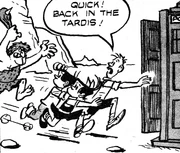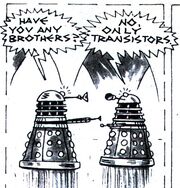- You may be looking for the in-universe ship.
TV Comic was a weekly anthology magazine published by Polystyle Publications, Ltd. in Britain from 1951 to June 1984. It held a licence to publish Doctor Who comic strips between November 1964 and May 1979.
History
Originally launched by the publisher of weekly publication, The News of the World (long before it was taken over by Rupert Murdoch), TV Comic was subsequently sold to Beaverbrook Newspapers. In 1960, the comic was sold it on to the newly-created TV Publications Ltd, which rebranded itself as Polystyle Publications from March 1968.
Initially, TV Comic was aimed at young children; the original front cover star was Muffin the Mule. Other regular strips included Mr. Pastry, Larry the Lamb, Tom Puss, Jack & Jill and Prudence Kitten. Over time, however, some of the content in TV Comic appeared to mature along with its original readers, although for much of its history there remained an ongoing tension between the action adventure strips aimed at older readers (some based on early series made by Gerry and Sylvia Anderson such as Supercar and Fireball XL5) and the numerous “funny animal” cartoon-based strips targeting younger readers.
As was common practice at the time among British comics publishers, several less successful publications were “merged” into TV Comic during its run, meaning it inherited some of their strips (if only temporarily). These included TV Land and TV Express (published by rival City Magazines) in 1962, sister Polystyle Publications title TV Action (formerly Countdown) in 1973, Tom and Jerry Weekly (Spotlight Publications) in 1974 (a nominal “merger”, given that original Tom and Jerry strips already graced the covers of TV Comic at the time), and Polystyle's short-lived crime action title Target in 1978.
The number of reprints used during its latter years – of both its own and other companies’ material – increased as budgets reduced. Nevertheless, for at least a year in 1976, the by-then rebranded New Mighty TV Comic became the first title in the world to publish both Doctor Who and Star Trek strips at the same time—the latter originated in the US by Gold Key Comics.
Despite its name, many of the comic’s strips were based around characters who had never featured on British television; indeed, the publication's longest-running strip was original creation Mighty Moth which ran from issue 384 (March 1959) until the final edition in 1984.
Having outrun most of its contemporaries, and all other publications published by Polystyle, there was no obvious title into which TV Comic could be "merged": the comic therefore simply ceased to appear after issue 1,697. The title was briefly succeeded the following year by weekly magazine Beeb, launched as BBC-focused response to "the Junior TV Times" title Look-in. However, Beeb ran for just 20 issues between January and June 1985. Polystyle Publications continued until 1997 when it was dissolved due to insolvency.
Editors of TV Comic included Dick Millington (who also edited juvenile sibling title Pippin and created Mighty Moth), Robin Tucheck, and John Lynott. Frequently commissioned freelance artists included Bill Titcombe (who was unusually given permission by MGM to create his own slightly-more-British version of Tom and Jerry), John Canning, Neville Main, H. Watts, Gerry Haylock, Mike Lacey, and Steve Maher.
Dr Who Strips
Throughout the TV Comic run of strips, the Doctor was primarily called "Dr. Who" by his companions and the narration. For convenience, the later-established incarnation numbering schema is used on this page instead of, for instance, "William Hartnell's Dr. Who".
For most of the run, Polystyle bought the minimum licence they could in order to publish a Dr Who strip: the name (but not the logo), the character of the Doctor and the TARDIS. (This was not exclusive to Doctor Who; other TV Comic strips based on popular shows or characters also sometimes “went their own way”, with sometimes interesting results.) Occasionally, though, Polystyle would extend their licence to include particularly popular companions, such as Jamie McCrimmon, Sarah Jane Smith or Leela. For the most part, though, TV Comic’s “Dr. Who” tended to travel with either specifically-created companions – such as his other grandchildren, John and Gillian, who travelled with both his First and Second incarnations – or “one off” characters who filled the “companion role” for a single story. (The exception to this was a young boy called Arnold, who briefly traveled with the Third Doctor before being returned home.)
As the comic rights to the Daleks were initially held by competing magazine TV Century 21, TV Comic opted to introduce their own recurring robotic villains called the Trods. However, in 1967, having secured the rights to use the Daleks, Polystyle used the Doctor's greatest foes to massacre the Trods in The Trodos Ambush. For a brief period the strip itself – given the added prominence of its opening page being on the front cover – was renamed “Doctor Who and the Daleks”—even though the Daleks did not feature in every single story.
After the rights to use the Daleks had been withdrawn by Terry Nation (as he pursued his dream of an American TV series), TV Comic instead licensed the Cybermen and the Quarks. With the former, it's clear that artist John Canning was never provided with any contemporary photographs of their more “robotic” evolution, as throughout their appearances in TV Comic, the Cybermen remained faithful to their initial appearance in The Tenth Planet.
The latter remains a rare example of a licensing/merchandising deal directly affecting the television programme, as the Quarks’ creators – Mervyn Haisman and Henry Lincoln – had not been consulted about the TV Comic deal; this contributed to the final breakdown of their relationship with the then-Doctor Who production team and the BBC. Haisman's and Lincoln's final serial for the show, The Dominators, was broadcast with a pseudonym.
Otherwise, most of the foes and enemies encountered by "Dr. Who" in TV Comic were original to the publication.
Regenerations
In 1966, TV Comic had coped easily enough with the change of the television show’s lead actor: since the switch between William Hartnell and Patrick Troughton had occurred mid-season, with only a week between episodes, TV Comic also simply switched from the First to Second Doctors between TVC 783 and TVC 784 (December 1966), with no comment or explanation given for John and Gillian’s “grandfather” suddenly looking significantly younger.
Three years later, however, the situation was somewhat different. Given the six month gap between the broadcast of Troughton’s final episode (which ended with the Doctor being sentenced to exile on 20th century Earth with a changed appearance) and Jon Pertwee’s first (when the regenerated Doctor arrived), TV Comic opted to initially exile the Second Doctor to Earth but not change his appearance. These Earth-bound adventures for the Second Doctor would subsequently help inspire the Season 6b theory.
In 1974, despite Jon Pertwee’s final episode first being broadcast in June, TV Comic simply continued publishing further adventures for the Third Doctor for the rest of the year, waiting until Tom Baker’s Fourth incarnation had appeared on television before switching to the new incarnation. On this occasion, however, the first episode of debut strip Death Flower did include a brief synopses of the ending of “Planet of the Spiders”, in order to introduce the new Doctor to readers.
Other Notable Developments
From the years 1971 to 1973, new Dr Who comics were published in TV Comic's sister magazine, Countdown/TV Action. Dr Who was subsequently one of three strips (the other two being Droopy and Dad’s Army) which initially transferred back to TV Comic when the two titles officially “merged”. (All three had first appeared in TV Comic before transferring to TV Action.)
In September 1976 TV Comic underwent the biggest relaunch in its history, becoming the newspaper-formatted New Mighty TV Comic (later Mighty TV Comic), which featured enlarged strips printed on cheap newsprint paper. The publication would ultimately return to the more traditional size and format used by British weekly comics at the time, and ultimately dropped the word “Mighty” from its masthead.
From the “Mighty” relaunch onwards, TV Comic began to increasingly rely on reprints and the re-use of old scripts applied to different characters. Notably, from TVC 1386 in July 1978, former TV Comic Second and Third Doctor strips (the latter illustrated by Gerry Haylock) were reprinted with the then-current Fourth Doctor's face. This budget-saving modification and reuse of pre-existing material – initially featured in the free "Doctor Who Comic" gifted with the first edition of New Mighty TV Comic – continued until TVC 1430, dated 11 May 1979, when Polystyle’s licence with the BBC came to an end.
The first issue of Doctor Who Weekly, published by Marvel Comics, would appear just five months later.
Comic stories
First Doctor
Second Doctor
Third Doctor
Fourth Doctor
- From Issues 1292 to 1325, the Doctor Who comic strip is reduced from the usual two pages to one.
Back-up strips



TV Comic used the Doctor and the Daleks in five known back-up comics, four times in "Pick of the Jokes" and once in TV Terrors. One notable aspect was that these cameos appear to follow licensing restrictions: for instance, Daleks did not appear in these comics until TV Comic obtained a license to use them from the Terry Nation Estate.
These comics are:
- TVC 696: In an untitled comic, the Doctor attempts to get back to the TARDIS, or perhaps just a police box, but is blocked by an officer.
- TVC 709: TV Terrors: An instalment of TV Terrors saw Monica, Buttons, and Cuthbert trying to meet "Dr. Who" after watching him on television.
- TVC 740: In another untitled comic, the Doctor enters a police box, only to find an officer exiting. The Doctor responds "Oops! Sorry! Wrong box!"
- TVC 794: In an otherwise non-Who strip, a child carries a small Dalek on a leash.
- TVC 798: In a third untitled strip, two Daleks talk, one speaking of their "transistors".
Special issues
TV Comic Holiday Specials
First Doctor
- TV Comic Holiday Special 1965
- TV Comic Holiday Special 1966
Second Doctor
- TV Comic Holiday Special 1967
- TV Comic Holiday Special 1968
- TV Comic Holiday Special 1969
Third Doctor
- TV Comic Holiday Special 1970
- TV Comic Holiday Special 1973
- TV Comic Holiday Special 1974
Fourth Doctor
- TV Comic Holiday Special 1975
- TV Comic Holiday Special 1976
- TV Comic Holiday Special 1977
- TV Comic Holiday Special 1978
TV Comic Annuals
First Doctor
Second Doctor
Third Doctor
- TV Comic Annual 1971
- TV Comic Annual 1975
Fourth Doctor
- TV Comic Annual 1976
- TV Comic Annual 1977
- TV Comic Annual 1978
- TV Comic Annual 1979
External links
- TV Comic Strips - First Doctor at the Doctor Who Reference Guide
- TV Comic Strips - Second Doctor at the Doctor Who Reference Guide
- TV Comic Strips - Third Doctor at the Doctor Who Reference Guide
- TV Comic Strips - Fourth Doctor at the Doctor Who Reference Guide
| |||||||||||||||||||
| |||||||||||||
| |||||||||||||||||||||||||||||
| ||||||||||||||||||||||||||||||||||||||||||||||||||||||||